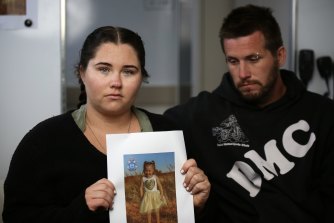Western Australia’s northern coastline is among the most remote in the country, its sparse landscape and endless horizons making it seem the perfect place for a person to disappear without a trace.
But the region has its own unique set of eyes and ears in unlikely places.

Cleo Smith went missing from the Quobba Blowholes campsite along WA’s remote northern coast on the weekend.Credit:Peter de Kruijff
As the search for missing four-year-old girl Cleo Smith enters its fifth day, investigators are methodically painting a picture of who was in the area the weekend the young girl was feared to be snatched from her family’s tent while camping north of Carnarvon.
Along the one sealed road and smaller limestone tracks out of the Quobba Blowholes campsite where Cleo was last seen are dozens of cattle grids, designed to stop station cattle from straying onto another section of land.
As a vehicle passes over the grids, some take an automated photo of the car’s number plate – an initiative station owners use to deter cattle theft.
The images could form an unlikely part in the police investigation into whether someone took Cleo, or whether she wandered off in the middle of the night without a trace.
The Minilya Roadhouse, 170 kilometres north of Quobba, also records every vehicle which passes along the North West Coastal Highway, the only road north out of the region.
Police seized CCTV from the roadhouse on Monday, the same day investigators recruited renowned Perth criminologist David Keatley, to assist with whether someone could have taken Cleo.
Cleo’s mother Ellie Smith pleaded on Tuesday for anyone with information about where her daughter was to come forward.
She and her partner Jake Gliddon have remained at the campsite since Cleo vanished, helplessly watching the massive land, sea and air search for their little girl return no clues to her whereabouts.
“We can’t do anything, it’s out of our hands, we just feel hopeless and out of control,” Ms Smith said.
“She would never leave us, she would never leave the tent, when she left she was wearing a jumpsuit and she can’t go to the toilet without my help unzipping it ... she would never leave the tent alone.
“If I think of her being taken a million other things cross my mind.
“I know she’s strong. Cleo was born eight weeks early, she was premature and she’s been strong since the day she was born. I know she can get through whatever she is going through.”
The family, who are Carnarvon locals, often camped at the Blowholes, and had arrived at the site at 6.30pm Friday with a new tent for their first trip as a family of four with younger daughter, Isla.

Cleo Smith’s mother Ellie Smith and partner Jake Gliddon.
Cleo woke and asked for water at 1.30am that night, and then returned to sleep. When Ms Smith woke at 6.30am to give Isla a bottle, her oldest daughter and the sleeping bag she was in were missing.
“Cleo was on a mattress, our little baby was in a cot right next to her, we had a divide and then we were on a blow up mattress as well,” she said.
“[In the morning] I went into the other room, the zipper was open and Cleo was gone ... the tent was completely open, it was about 30 centimetres from being open.“
Murdoch University forensic scientist Paola Magni said it would be likely, if Cleo was taken, her abductor would have left forensic clues inside the tent.
“In the situation of a missing person, or a missing child, everything has to be considered as a potential crime against a person,” she said.
“If an adult has to come into a tent, there is a chance the person will touch the tent somewhere, so will leave some traces somewhere in the tent.”
“Technology allows us to take fingerprints even if they are not visible, and if we want to go even further, if someone wears a glove, if the glove is not completely sterile, you can leave part of your DNA in a certain place.”
Dr Magni said police would likely be overloaded with information in the first few days of the search, with the hopes of finding Cleo alive fading with each day that passes.
Digital forensic work, such as retrieving all the phone numbers which pinged the Point Quobba mobile phone tower, would also be crucial to the case and determining who was in the area.
“This is a very similar case to Lindy Chamberlain, but the technology and the advances in forensic research has been massive in 40 years, so we go from basic magnified lens type of investigation to micro-sequencing DNA,” she said.
Ms Smith was confident someone had seen her daughter in the past five days, asking people to call police if they’d seen anything suspicious.
“[The past few days] have been horrendous, we haven’t really slept, we’ve had so much family help us, support us. But you know like everyone asks us what you need, all we really need is our little girl home,” she said.
Anyone with relevant information about the disappearance should pass it on immediately to WA Police by ringing 131 444.
Most Viewed in National
https://news.google.com/__i/rss/rd/articles/CBMijgFodHRwczovL3d3dy5zbWguY29tLmF1L25hdGlvbmFsL2NhdHRsZS1ncmlkLWNhbWVyYXMtYW5kLWNjdHYtZXllcy13YXRjaGluZy13YS1zLXJlbW90ZS1ub3J0aC1jb3VsZC1oZWxwLWZpbmQtbWlzc2luZy1naXJsLTIwMjExMDE5LXA1OTFkdC5odG1s0gEA?oc=5
2021-10-19 20:15:37Z
52781940990540
Bagikan Berita Ini















0 Response to "Cattle grid cameras and CCTV: Eyes watching WA’s remote north could help find missing girl - Sydney Morning Herald"
Post a Comment